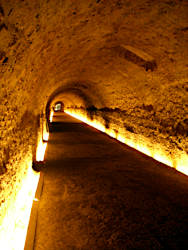Circ romà
Useful Information

| Location: |
Rambla Vella, 2, 43003 Tarragona.
(41.115822, 1.256902) |
| Open: |
APR to SEP Tue-Fri 9:30-21, Sat 10-21, Sun, Hol 10-15. OCT to MAR Tue-Fri 9-20, Sat 9:30-20, Sun, Hol 9:30-14:30. [2023] |
| Fee: |
Adults EUR 5, Children (13-17) EUR 2.50, Children (0-12) free, Students EUR 2.50, Seniors EUR 2.50, Unemployed free. Groups (20+): Adults EUR 2.50. [2023] |
| Classification: |
 Catacomb Catacomb
|
| Light: |
 Electric Light Electric Light
|
| Dimension: | |
| Guided tours: | self guided |
| Photography: | allowed |
| Accessibility: | no |
| Bibliography: | |
| Address: |
Circ romà, Rambla Vella, 2, 43003 Tarragona, Tel: +34-977-24-22-20.
E-mail: Municipal Tourism Office, C/Major, 37, 43003 Tarragona, Tel: +34-977-25-07-95. E-mail: |
| As far as we know this information was accurate when it was published (see years in brackets), but may have changed since then. Please check rates and details directly with the companies in question if you need more recent info. |
|
History
| 2000 | inscribed on the UNESCO World Heritage List. |
Description
The Circ romà (Roman circus) of the Roman city Tarraco was built at the end of the 1st century AD, during the reign of Domitian. It is a circus or chariot racecourse, an oval elongated area with a flat area in the center where horse and chariot races took place. The outer part, separated by a high wall was row after row of seats for about 30,000 spectators. Typically, such a building, which needed a lot of space, was built outside the city limits. Actually there was no need to defend it, as it was just a racecourse, there were no valuables and nobody was living there. Here in Tarragona its different, the amphitheatre was located within the city limits and as a result has several atypical architectural features. And despite the fact that most above ground structures are destroyed, it is considered one of the best-preserved circuses in the West. Some of it is excavated and may be visited, some parts are still hidden under 19th-century buildings.
The site has a tower which is called Praetorium, in Spanish Torre del Pretori, it housed the staircase that connected the lower city to the provincial forum via the circus. Located on one of the corners of the vast rectangle of the provincial forum, it is connected to the circus by an underground passage. During the 12th century it was transformed into a palace for the King of Aragon. In the 16th century it was converted into a prison.
The Circus and the Praetorium are managed by the Museu d’Història de Tarragona MHT (Tarragona Museum of History). They are part of the Roman Tarraco archaeological complex declared a UNESCO World Heritage Site in 2000. The entrance ticket includes both sites, entrance is at Rambla Vella, 2, at the southern side, exit is at the staircase north of the Praetorium. There is also a combo ticket for all six archaeological sites managed by the MHT, the Archaeological Promenade, the Circus/Praetorium, Colonia Forum, Amphitheater, Casa Castellarnau, Casa Canals.
- See also
 Subterranean World Heritage List
Subterranean World Heritage List Search DuckDuckGo for "Circ romà Tarragona"
Search DuckDuckGo for "Circ romà Tarragona" Google Earth Placemark
Google Earth Placemark Praetorium and Roman Circus (MHT) (visited: 12-MAY-2023)
Praetorium and Roman Circus (MHT) (visited: 12-MAY-2023) Provincial Forum And Roman Circus (visited: 12-MAY-2023)
Provincial Forum And Roman Circus (visited: 12-MAY-2023) Circ romà
Circ romà  (visited: 12-MAY-2023)
(visited: 12-MAY-2023) Archaeological Ensemble of Tarraco - UNESCO World Heritage List (visited: 12-MAY-2023)
Archaeological Ensemble of Tarraco - UNESCO World Heritage List (visited: 12-MAY-2023)
 Index
Index Topics
Topics Hierarchical
Hierarchical Countries
Countries Maps
Maps